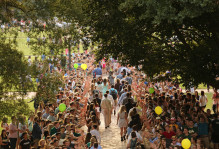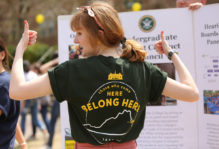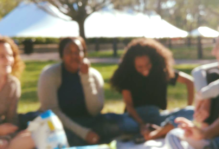Building Trust in Community – Part II
When I applied for the Community Trustbuilding Fellowship, I did so because I hoped it would inform my work in the Office of Community Engagement, equipping me with tools to work with others in small groups for social change. And, I knew it wouldn’t be an easy experience. One of the major goals of the Fellowship is to work on yourself, and another is to understand and own our shared history of racism and unhealed historical wounds. As a white woman (with many other elements to my identity), who grew up in the US South and has ancestors from both the South and North, I was signing up for a lot of personal and interpersonal work.
Our second fellowship weekend was entitled, “Healing history: creating a new narrative for communities.” We explored the history of Richmond by walking the Trail of Enslaved People, or the Richmond Slave Trail. This walking trail includes stops throughout downtown Richmond and tells parts of the stories of the trade of enslaved people, resistance and uprising led by enslaved and free people, and recent efforts toward healing.
We began our walk atop Libby Hill, one of the highest points in Richmond, a place with fraught and layered history. As our faculty pointed out, we were standing on earth that contained the graves of many members of the Powhatan Confederacy, the early inhabitants of this land. Behind us as we looked over the river was the Confederate Soldiers and Sailors monument, memorializing those who died while fighting for the South in the Civil War. And below, we saw the places on the James River where enslaved Africans first set foot at the Manchester Docks and Rocketts Landing, many returning later to be sold down the river – literally – to people in other parts of the country.
Throughout the day, we walked on ground that had held the footsteps, lives, and torture of people who had been enslaved. We walked the path along the river by the Manchester Docks, holding hands with one another, and returning with our hands on each other’s shoulders, recognizing that those who were enslaved walked this route in handcuffs and chains. We visited the African Burial Ground, touching the ground and trees there, learning from the work of two historians in our cohort who have memorialized those buried there and elsewhere.
Each of us had our own experience, no doubt rooted in our understanding of history, the unique ways race and racism affects us today, and the diverse ancestral connections we each hold to these places and people.
For me, debriefing the experience that afternoon one on one, in small groups, and in the large group, brought many of my stories, actions, and ancestral connections together. I was face to face with my privilege and responsibility, the stories I know about my family, and what it means for me as a white person to work for racial healing and justice today. These are not quick things to learn, and this is not my first time engaging in this work. It is a process that unfolds over time, through persistence and commitment to self-examination and relationship. It is the kind of work that forces me to look critically at my thoughts, actions, and words. It is the kind of work that calls me to speak my perspective clearly, and to accept and integrate feedback about how I affect others.
At one point in during the weekend, a side comment came up that made me think hard about one question in particular: Am I proud to be a white woman? My response at that time is still true a couple of weeks later: “Well, that’s a longer conversation.” It is. And as I prepare for our next weekend together, and my daily work of justice in these areas, it is a conversation I will continue to have in my own heart and with others whom I trust to hold it, with challenge and grace.




No comments.
Comments are currently closed. Comments are closed on all posts older than one year, and for those in our archive.